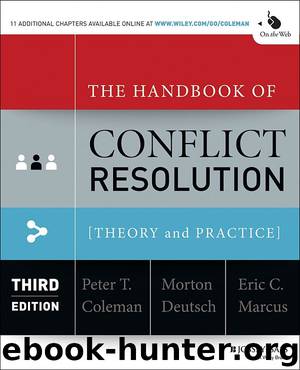The Handbook of Conflict Resolution (3rd ed) by Peter T Coleman & Morton Deutsch & Eric C Marcus

Author:Peter T Coleman & Morton Deutsch & Eric C Marcus
Language: eng
Format: azw3
ISBN: 9781118810330
Publisher: Wiley
Published: 2014-02-28T05:00:00+00:00
Negotiators from monochronic cultures tend to
Prefer prompt beginnings and endings
Schedule breaks
Deal with one agenda item at a time
Rely on specific, detailed, and explicit communication
Prefer to talk in sequence
View lateness as devaluing or evidence of lack of respect
Another dimension of time relevant to negotiations is the focus on past, present, or future. National cultures, including those of Iran, India, and East Asia, lean to accenting the past, while the United States tends to be oriented to the present and the near future. Latin American peoples have both present and past orientations, while indigenous peoples in the Americas often use a past and future-oriented approach to time, stretching seven generations forward and back. Parties or third parties focused on the present should be mindful that others may see the past or the distant future as part of the present. Those for whom time stretches into the past or the future may need to remember that a present orientation can bring about needed change.
Of course, no one group fits neatly on a continuum; we all have some capacity to move around. A traumatic event may catapult an entire group into a focus on the past once the immediate crisis is over; a society experiencing rapid economic growth may spend a lot of time contemplating the future that is fast approaching. Differences abound within groups not only in relation to generation, but also in relation to many other aspects of identity. At the same time, conflict is likely to escalate when those involved do not realize, or discount, the extent to which different relationships to time are confounding their communication.
The importance of these differences in relation to time came home to me when I offered negotiation training in relation to land claims to representatives of two levels of government and First Nations people in British Columbia. During introductions, the First Nations people welcomed everyone to their traditional territory with a prayer in their language, then began a narrative account of their history with the preface: “Seven generations ago . . .” When the government representatives were asked to make introductory remarks, they projected PowerPoint slides of the steps for ratification and adoption of an eventual agreement. The vastly different starting points in relation to time also played out in the way the three groups wanted to structure meetings, their attitudes to punctuality, ideas of what constituted effectiveness, and their attributions about each other. Though the time-related differences were not a surprise to anyone, they still functioned to make communication and progress more difficult.
It is beyond the scope of this chapter to explore other cultural continua identified by interculturalists. Interested readers are directed to the online web resource Beyond Intractability (http://www.beyondintractability.org/), especially the essay on cross-cultural communication (LeBaron, 2003). Other continua address a wide range of starting points, including these:
Spatial orientation—how close it is comfortable to stand, how furniture should be arranged, who should be seated where
Affiliation and agency—individual autonomy versus group decision making
Communication content and approach—directness and indirectness and the related ideas of high
Download
This site does not store any files on its server. We only index and link to content provided by other sites. Please contact the content providers to delete copyright contents if any and email us, we'll remove relevant links or contents immediately.
Cecilia; Or, Memoirs of an Heiress — Volume 1 by Fanny Burney(32495)
Cecilia; Or, Memoirs of an Heiress — Volume 2 by Fanny Burney(31909)
Cecilia; Or, Memoirs of an Heiress — Volume 3 by Fanny Burney(31893)
The Great Music City by Andrea Baker(31758)
We're Going to Need More Wine by Gabrielle Union(19003)
All the Missing Girls by Megan Miranda(15779)
Pimp by Iceberg Slim(14434)
Bombshells: Glamour Girls of a Lifetime by Sullivan Steve(14022)
For the Love of Europe by Rick Steves(13594)
Talking to Strangers by Malcolm Gladwell(13291)
Norse Mythology by Gaiman Neil(13279)
Fifty Shades Freed by E L James(13187)
Mindhunter: Inside the FBI's Elite Serial Crime Unit by John E. Douglas & Mark Olshaker(9263)
Crazy Rich Asians by Kevin Kwan(9223)
The Lost Art of Listening by Michael P. Nichols(7453)
Enlightenment Now: The Case for Reason, Science, Humanism, and Progress by Steven Pinker(7273)
The Four Agreements by Don Miguel Ruiz(6701)
Bad Blood by John Carreyrou(6583)
Weapons of Math Destruction by Cathy O'Neil(6215)
